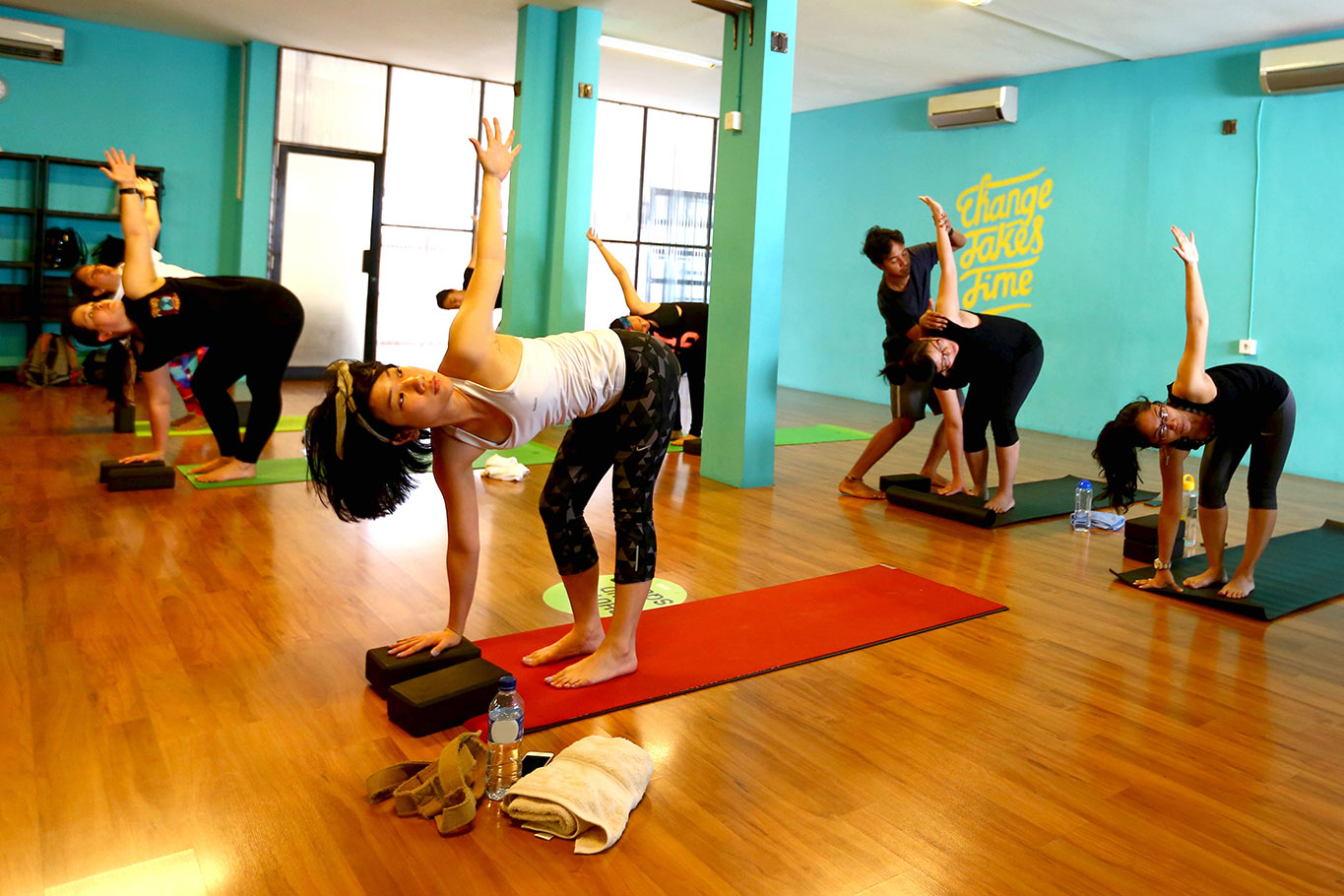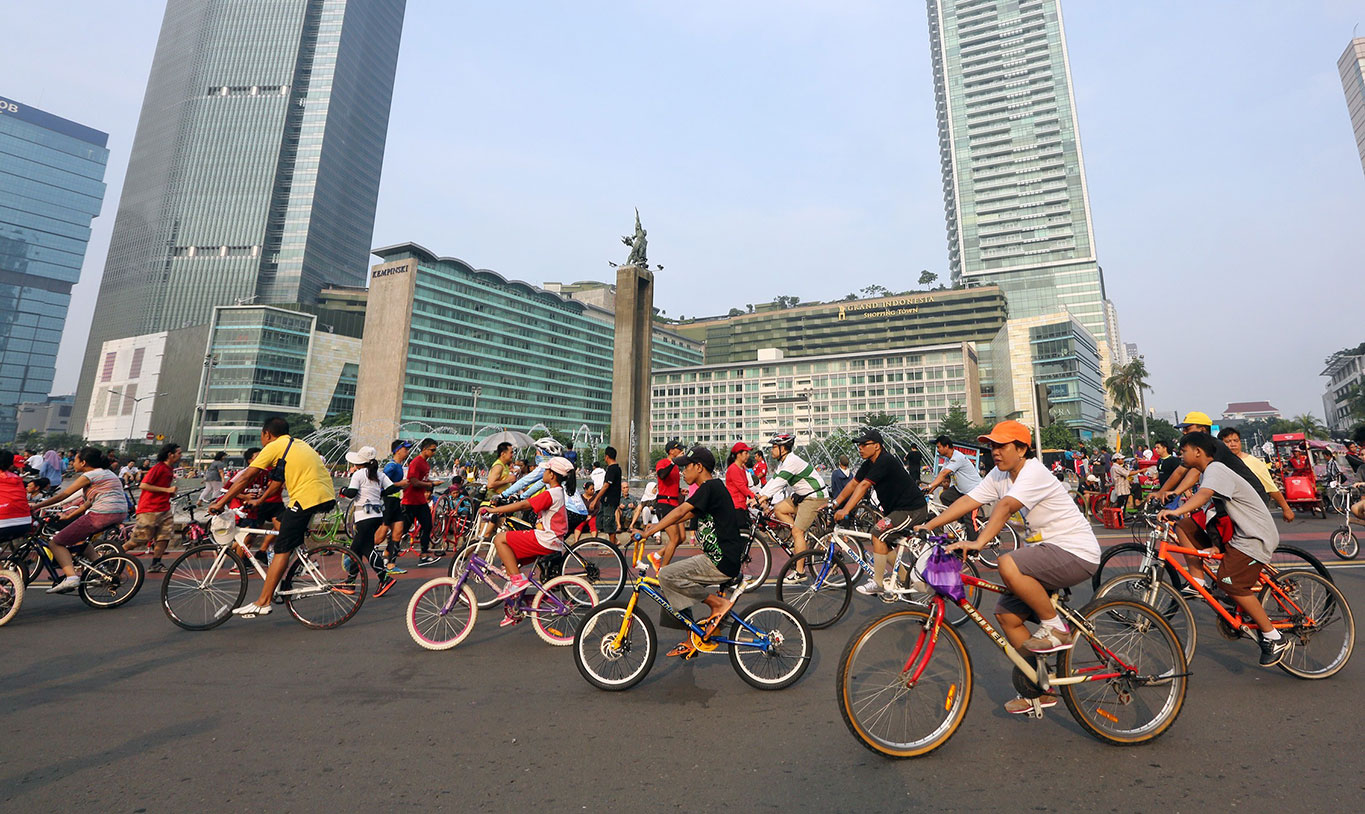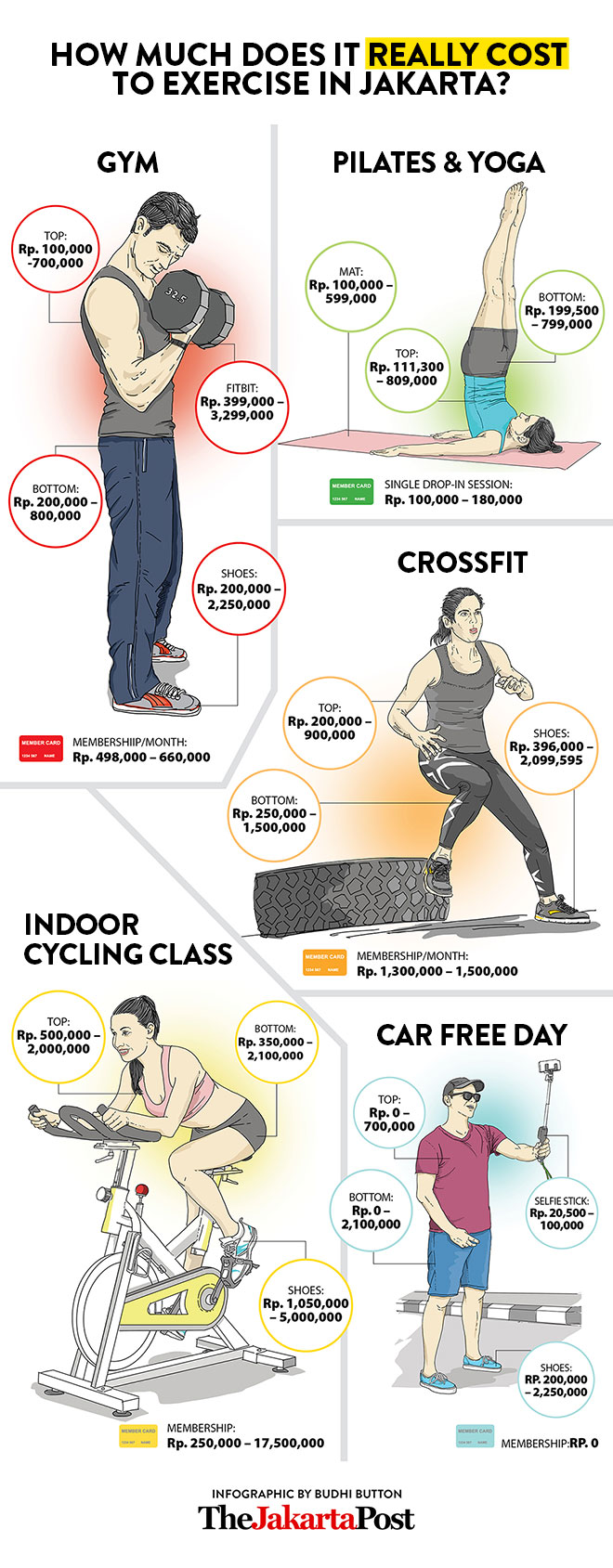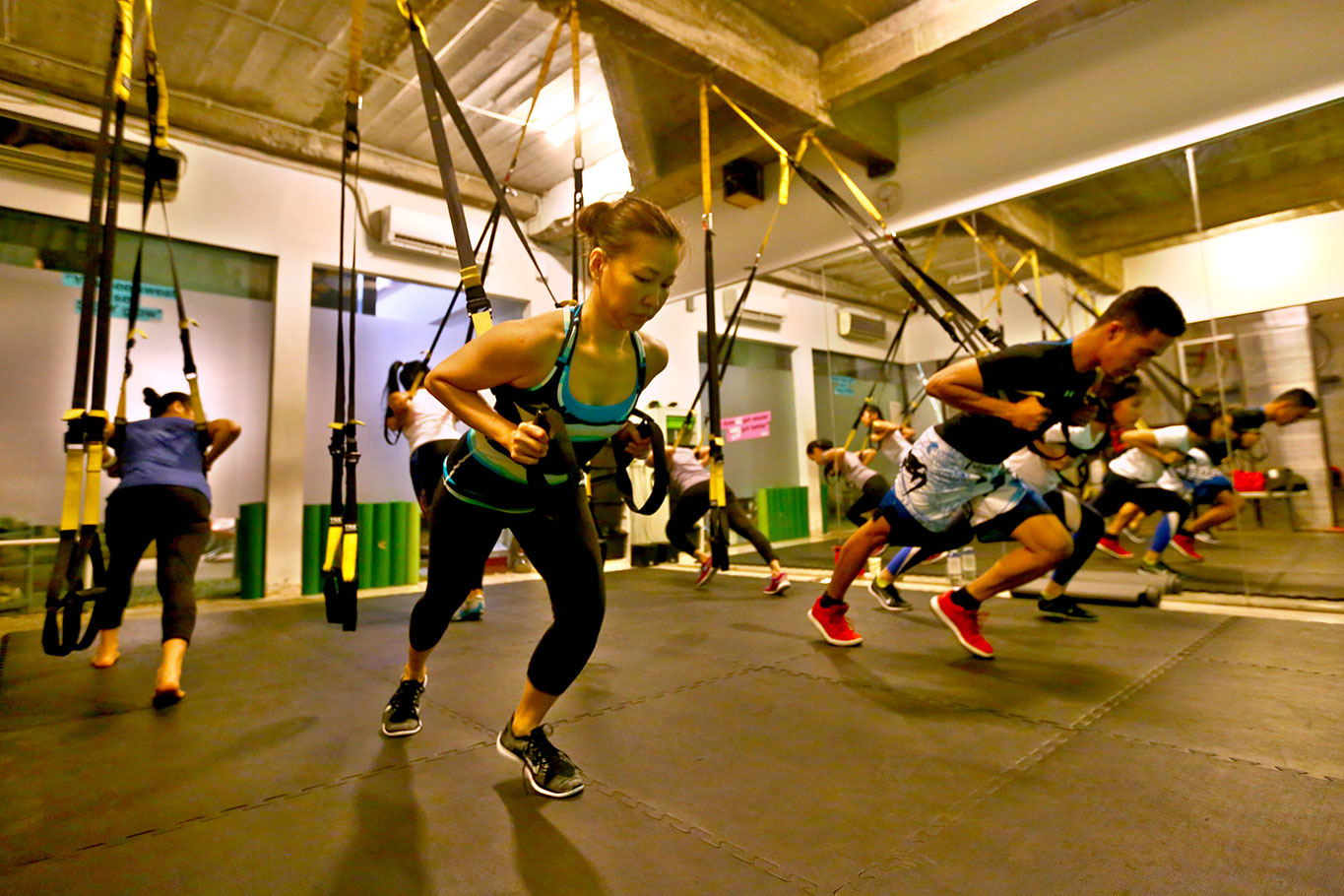Tracing down the health and fitness pattern of Jakartans
A typical day for Jakartans revolves around waking up at the break of dawn, getting inside cars or hopping on motorbikes to confront harsh traffic or lining up for public transportations with the hope of getting safely to their workplaces. In the middle of this commuting routine, Jakartans usually stop by at a coffee shop drive thru or street side food carts selling nasi uduk or fritters for the so called “power breakfast”.
Arriving at the office, a typical working-class Jakartan will sit for hours in front of a computer, making phone calls, attending meetings and other mundane activities until the clock hits 6 p.m.
When the work hour is over, it’s another battle against the same hellish traffic before reaching home and finally able to call it a day.
Because time is very valuable for most urbanites, the constant juggle between traffic, work and downtime, they are left with very little time -if none at all to spare for exercise. However, more and more Jakartans are now aware of self-maintenance, and are now living in a world where Fitness and Health Centers exist in almost every area of the city.
The Post takes you on a tour back in time and back to the present day, to see the evolution of exercise among Jakarta’s urbanites.
Blast from the past: Aerobics classes
Most Indonesian women who grew up in the 80s era are familiar with aerobics classes scattered around the city. The modest setting of mirror-walled garage and friendly environment catered not only as an exercise place, but more to a social venue among housewives and younger women living nearby.
Berty Tilarso became the household name in that exact decade, as she ushered in the aerobic craze in Indonesia. In the era with limited media access, she was first known to the public from her monthly column in women’s magazine Kartini.
Berty was approached by the only TV station, the state-owned TVRI, to do a Sunday morning show called “Sehat dan Bugar” (Healthy and Fit). Entering the millenium in the year of 2000, she released workout VCDs featuring different ranges of cardio movement from aerobic to hip hop.
When TheJakartaPost.com visited her studio in Bintaro, Berty who is now 66, was teaching a small group of women from Malaysia. After more than a decade and dozens VCDs later, her studio is still going strong, still gaining new members consisting of women above 30, or simply put, those who grew up seeing her on TV and buying her videos.
“These women are here not for getting themselves to look muscular, as a matter of fact they are scared of becoming one,” says Berty, who is fine with the demographic, noting that members who come to her studio are mostly aimed for losing weight and keeping themselves healthy.
Entering the millennium, a new craze hit Jakarta, where gymnasiums which formerly were only available in luxury hotels became accessible to the general public. However we couldn’t help but wonder: nearing their second decade of existence, are they still Jakartans’ favorite place to exercise?
Serving the working class: Fitness centers
To date, there are three brands currently dominating the metropolis: Celebrity Fitness, Gold’s Gym and Fitness First. These gyms ensured that everyone from corporate workers to stay-at-home moms are able to exercise at anywhere and anytime and make it a part of their daily routine, just like grabbing a cup of coffee.
The fitness industry is evidently growing in this country, Gold’s Gym itself currently has about 70,000 active members, a 40% increase from last year (source: bisnis.com) that belong to the middle – upper class market. Francis Wanandi, 46, founder and chairman of Gold’s Gym Indonesia credited the rise of technology and easy access to information that make people becoming more health-conscious.
“There’s not enough space for Jakarta people to move, so that’s why our presence become important because we can provide the needs of the people,” says Francis.
He also adds that gym provides the comfort of working out in an indoor area without having to deal with the chaos of Jakarta.
29-year-old Andi Agustinus has been a member of Celebrity Fitness for nine years, “It’s convenient for me, the gym has many workout exercise equipment and classes to try on. Classes here are also fun and challenging, and you get to meet new people and make friends” says the relations officer who admits he workouts one to three times a week.
He prefers going to the fitness chain since it’s closer to where he lives and the price is also more affordable than that of boutique studios.
“Studios are on a pay-per-visit basis, while at Celfit I pay a monthly fee and I’m free to come anytime I want.”
Another gym-goer, Wenni Setiorini, 38, loves working out at Fitness First located close to where she works because members there don’t have their own “gym cliques”.
“Members at FF are mostly office workers, we do socialize but not in a arisan (social gathering) kind of way, and I’m mostly on a treadmill when I workout. I don’t like the pressure of having to perform on the same level as other members when I’m in a group exercise,”she says.
While not into group exercises, the marketing director at an e-commerce company is keen in trying out one-on-one boutique exercises.
“I would like to try Muay Thai, it’s a one-on-one session between me and the trainer and it’s also a high-impact exercise which is what I love to do.”
Just like Andi, Billy Chailani a Gold’s Gym member who works as a freelance group exercise instructor while juggling his full-time job as a communication consultant at a PR company enjoys going to classes offered at the gym.
“I’m generally more into group exercise since it gives you the sense of participation and competitiveness. You don’t want to look lame in the sea of gym members,” says the 22-year-old who also shows interest for trying boutique studios.
“But at this point those kind of studios are kind of niche. The numbers are not that many, so price is still an issue, although the comfort of less people inside the studio is unquestionably beneficial.”
Community based workout and boutique studios
As 2014 loomed, health-conscious Jakartans experienced the new boom of boutique studios promising community-based, quick workout session and self-improvement. The rate per-session don’t come cheap, as each session can make you shell out up to more than a hundred thousand Rupiah.
The opportunity of making these boutique studios more affordable to interested exercisers is sought by a Singapore-based app called GuavaPass. The online platform, released in Indonesia back in January 2016, currently partners with up to 50 studios, giving access to its users enabling them to sample different classes at these venues with a maximum of 3 to 5 sessions per studio each month.
“The ones that are super packed located in SCBD area cause that’s where people go the most but right now I also see the trend going to the North and South like in Kemang and Senayan,” says Indonesian GuavaPass representative Jovita Widjaja.
From the price range, Rp. 100,000 – Rp. 300,000 ( $7.5 - $ 22.7 ) for a single drop-in class, and locations, it’s obvious that these boutique workout studios targeted the upper class market, yet somehow the trend is spreading like a wildfire around the metropolis. To investigate the rapid development of the trend, we visited several studios located around central and south Jakarta area.
Located at the basement parking of Fairground, SCBD, Bengkel CrossFit is a dimly-lit studio specialized in, well, CrossFit. It’s a program first founded in California that incorporates functional movements from gymnastics, weightlifting, running, rowing and many more, performed at high intensity. Every individual’s performance during the Workouts of the Day (WODs) challenge is scored on a board with the purpose of making it more fun and competitive.
CrossFit has had negative press surrounding it with stories of in-your-face coaches who force you to lift weight you couldn’t handle, intense members who compete with each other and have their own gym squads. However, what we encounter during the evening class is the polar opposite.
In the studio English is the first language though sometime Bahasa Indonesia is spoken mid-sentence, members and coaches are mostly expatriates or people who have traveled or lived abroad. Everyone looked very relaxed, and the bond shared between members is almost family-like. Prior the class the participants, coach included, gather up together for friendly conversations and during the session it’s clear that there is no pressure to perform better than next person. The biggest competition is themselves with the coach encouraging everyone in a motivational manner.
Jennifer Mulianto, is an athlete who’s currently training for CrossFit competition, is one of the class’ participants that night.
“It helps me in terms of not only being active and fit but also builds up my strength. It helps you to be stronger as well at the same time and the most important thing for me it’s always fun, it doesn’t get boring for me to train,” says the 31-year-old.
Scott Hanna, 35, the founder of Bengkel CrossFit believes people love doing it because of the competitive challenge of the workout itself and the sense of community, friendship and bonding that come with it.
“Here, there’s lots of things that support building friendship and network. There’s a culture where every day everyone writes their name next to the workout on the board and then they write their score, so then you automatically get to know people’s names. Also because everybody’s doing the same thing it’s more natural for them to know each other,” says Scott.
Within the compound, right at the end of the CrossFit studio there’s a door next to a “RiDE” sign painted on the wall. Inside, an indoor cycling class is currently taking place. The room is nearly dark, upbeat music is playing with people pedaling with excitement and exhaustion at the same time, trying to keep up with the instructor’s commands.
Ride Jakarta adopts the same workout concept as the elite boutique studio Soul Cycle in the US that’s been gaining a lot of attention due to its A-list clientele. Gita Sjahrir, 34, owner and trainer of Ride Jakarta spent most of her adult life in the US, where she used to join indoor cycling class back in New York.
Due to her missing the kind of indoor cycling classes which are similar to what she’s used to in the Big Apple, Gita decided to fly back to the US and take up training to be an instructor. She opened her first studio last year and currently has several hundred members who call themselves “Riders”.
“I like that they come in here not just because they want to torture themselves but because they really enjoy the workout. For them it’s 45 minutes of just losing yourself in the experience and not even thinking that you’re working out,” she says.
Gita is well-aware that Jakartans are different than New Yorkers in terms of workout habits and active lifestyle. According to her the locals are getting more into healthy lifestyle as evidenced by the growing of boutique fitness and fun runs.
“If you’re looking at the young demographic with high purchasing power and also growing middle upper class demographic you will definitely start seeing people wanting to try different lifestyle options. so right now you have cafes, bars but there’s a certain point in time where your demographic will want something more than that cause it gets boring to just go out and go out. The best part of that is you can have multiple lifestyle options with the boutique studio,” Gita explains.
The same sentiment is also expressed by one of Sana Studio founders Abimantra Pradhana. The studio that he co-found together with other 3 relatives offer many different classes including Zumba, TRX and Pilates. Unlike the previous two boutique studios, Sana Studio is located at Panglima Polim, one of the hottest location for up-and-coming start-up companies.
 A workout session at Sana Studio. (The Jakarta Post/ Wienda Parwitasari)
A workout session at Sana Studio. (The Jakarta Post/ Wienda Parwitasari)
The 33-year-old credited the government-initiated Sunday morning Car Free Day program as one of the factors that brings health awareness to millennials. The Car Free Day, which has been held every Sunday since 2012, is the government’s effort in trying to lower down the pollution level in Jakarta. Tens of thousand residents come to the city center every Sunday for a jog, walk or bike on the streets that are usually congested with vehicles on weekdays.
“The lifestyle of millennials has shifted. Before it was about going to clubs, partying all night long. Now, ever since we have Car Free Day policy, morning run is the new cool,” he says.
Car Free Day grew more and more popular, Jakarta’s trendsetters wanted to have a little of the action. Actress Dian Sastro popularized trendy hashtags such as #pertemanansehat (#healthyfriendship) and #jangankasihkendor (#keepittight) in her Instagram account as well as her other celebrity friends’. The idea is to get everyone of posting photos of their group workout, on their social media using the hashtags.
 Jakarta's Car Free Day ( CFD ) policy closes off the capital's main roads in Central Jakarta to vehicles on Sunday mornings. (The Jakarta Post/ Ricky Yudhistira)
Jakarta's Car Free Day ( CFD ) policy closes off the capital's main roads in Central Jakarta to vehicles on Sunday mornings. (The Jakarta Post/ Ricky Yudhistira)
“This campaign encourages people toward a more active lifestyle. I’ve been noticing many Instagrammers catching up with this trend, they go workout together in a group and then post their photos on social media,” says radio announcer Ucita Pohan, one of the hastags’ content creators.
Another establishment accommodating the exercise craze is Jakarta’s 54 year-old sports stadium, Gelora Bung Karno (GBK). Built in 1962, Gelora Bung Karno has been a gracious host to various regional sport games, and for generations, this place has become the city’s sports public facility.

Master Bootcamp, another form of boutique fitness, has its basecamp at GBK. The workout originated from the idea of having an outdoor group exercise, emphasizing in total body workout experience; a combination of exercises that move together all body parts within a single hour. The participants is varied from 16 to 55 year-olds, most who are bored with indoor exercises.
Currently Master Bootcamp only has one session every week which falls on Saturdays from 6 to 7 a.m. 35-year-old Carlo Tamba, founder of Master Bootcamp who also happens to be a CrossFit coach told us that morning time in Jakarta is still considerably safe from air pollution. Carlo also noted the safety factor for the participants: GBK is a gated area where vehicles can’t roam freely on the streets.
“This program fits into many people in Jakarta who do every single activity surrounded by walls. We want to encourage them in enjoying Jakarta’s beautiful morning scenery that they are missing out on weekdays. Another reason why Master Bootcamp is appealing, it’s the spirit of community formed between our regular participants,” he says.
The rapid growth and people’s increasing interests of these various boutique fitness studios, however, does not seem to worry the establishments that has been the previous choices.
Berty Tilarso is far from worried about the pressure to keep up with the current boutique fitness craze, as she said trends always come back in full circle.
“I used to teach Zumba back in the days, it was called hip hop and it’s now trending again. Even Pilates, we used to call it calisthenics workout.”
Gold’s Gym owner, Francis Wanandi, also remain unfazed. He likens this constantly evolving trend to that of retail and department stores.
“This is like retail right? Because there’s a lot of boutique retail doesn’t mean that department stores are dying. Sometime you go to department stores but you also buy from boutique stores as well,” he explains. “The good thing is all those boutique studios make the business itself exciting, it’s growing.”
| Managing Editor Life | : | Asmara Wreksono |
| Editor | : | Keshie Hernitaningtyas |
| Reporter | : | Dian Arthen |
| Technology | : | Muhamad Zarkasih, Muhammad Kurnia |
| Multimedia | : | Bayu Widhiatmoko, I.G. Dharma J.S., Ahmad Zamzami, Rian Irawan, Budhi Button |
| Photographer | : | Wienda Parwitasari, Ricky Yudhistira |


